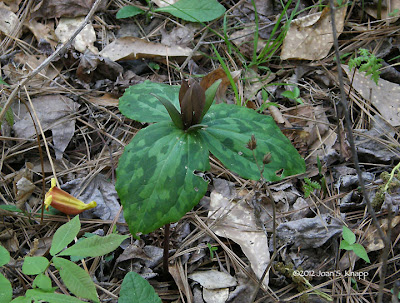On March 10th, as we made our way over to the Mayapple patch, we found a cluster of Devil’s Urn or Black Tulip fungus (Urnaria craterium). These were young fungi and took a little effort to identify because the photographs in our reference books were older and looked different from those we had seen.
 Young fungi, looking from above.
Young fungi, looking from above.  From the side.
From the side.We arrived at Stalking Head Creek on March 24th . to photograph Mayapple flowers along the ledge above Stalking Head Creek. We made our way back to the truck by walking along the ledge against the hill. As we walked back up the slope to the road, we stumbled on another patch of Devil’s Urn. There included a few young fungi but also older fungi that resembled the photos in identification manuals.
 A cluster of young fungi.
A cluster of young fungi. A single fungus
A single fungus A cluster of older fungi. The cup to the right is the youngest of the cluster
A cluster of older fungi. The cup to the right is the youngest of the clusterOn April 21st, we found them again as we returned to the car after photographing developing Mayapple fruit.
 Old fungi. These have almost dried up now.
Old fungi. These have almost dried up now.I’m sure we’ll return in search of these fungi in future years – and look for them in other areas. The only stage we haven’t seen yet is the unopened fungus.
Click on an image to view a larger image
Identification resources:
- Jim Conrad, Backyard Nature: Devil's Urn (Urnula craterium)
- Encyclopedia of Science: Fungi - Ascomycota
Related Posts:
- Piedmont National Wildlife Refuge: Late Winter Surprises (Part 5)
- Piedmont National Wildlife Refuge: Atamasco Lily (Zephyranthes atamasco)
- Jasper County, Georgia: Red-banded Hairstreak (Calycopis cecrops)
- Jasper County, Georgia: New Life – Bracken Fern (Pteridium aquilinum) & Green-and-gold (Chrysogonum virginianum)
- Piedmont NWR: Flowering Dogwoods (Cornus florida)
- Piedmont NWR: Bulbous Bittercress (Cardamine bulbosa)
- Piedmont NWR: A Wildflower Miscellany
- Fowler’s Toad (Anaxyrus fowleri)
- Mushrooms At Stalking Head Creek
- Mayapples (Podophyllum peltatum) At Stalking Head Creek













































